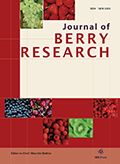Authors: Qamar, Muhammad | Akhtar, Saeed | Ismail, Tariq | Sestili, Piero | Tawab, Abdul | Ahmed, Nadeem
Article Type:
Research Article
Abstract:
BACKGROUND: Berries indigenously grown in Asia are known for their diversified nutritional and health promoting properties. Establishing a link between berry consumption and their classical uses in health management however requires detailed research in exploring varied biochemical factors and their therapeutic role in averting risks of chronic disorders. OBJECTIVE: The present study was aimed at evaluating anti-inflammatory and anticancer responses of fruit extracts of Grewia asiatica locally known as Phalsa . METHODS: Dichloromethane, methanol and 50% hydro-methanolic fractions of fruit were evaluated for polyphenols characterization, quantification and antioxidant assays. Anti-inflammatory and anti-nociceptive responses of fruit
…extracts were evaluated in rats and mice models, respectively, and cytotoxic activities were measured against MCF-7, HeLa, HEp-2, NCI-H522, HEK-293 cancer cell cultures. RESULTS: Phenolics quantification and biological study data suggested 50% hydro-methanolic extracts as maximum carrier of flavonoids (7.92 mgQE/g), anthocyanins (8.1 mg/Kg) and tannins (187.2 mgGAE/g) that significantly (p < 0.05)resulted in higher oxidation inhibition (IC50 41.1 ug/ml), paw edema inhibition (68–74%) and pain mediation in neurogenic phase(31–62%) when administrated at the rate of 400 mg/kg b.w. Maximum cytotoxic activity of G. asiatica (50% hydro-methanolic extracts) was observed against MCF-7 (IC50 34.9 ug/mL), HEp-2 (IC50 80.4 ug/mL) and NCI-H522 (IC50 73 ug/mL) cancer cell lines. LC-ESI-MS/MS characterization of hydro-alcoholic fractions bearing potent biological activities revealed Gallic acid, Ellagic acid, Quinic acid, Calycosin, Vidalenolone, Quercetin, Myricetin, Liquitrigenin and 6-aldehydo-isoophiopogonone. Human equivalent doses of the extracts calculated on the basis of total phenolic contents for anti-inflammatory and nociceptive assays were in range between 6.2–15.8 mg/kg b.w., and 3.1–7.9 mg/kg b.w., respectively. CONCLUSIONS: Findings of the study suggest G. asiatica fruit extracts are a potential source of bioactive compounds that might further be explored for anti-inflammatory and anticancer drug discovery and its clinical exploitation. Study concludes supplementation of G. asiatica extracts as possible approach to acquire curative properties in human subjects.
Show more
Keywords: Grewia asiatica
, inflammation, cancer, cytotoxicity, breast
cancer
DOI: 10.3233/JBR-190459
Citation: Journal of Berry Research,
vol. 10, no. 1, pp. 115-131, 2020





